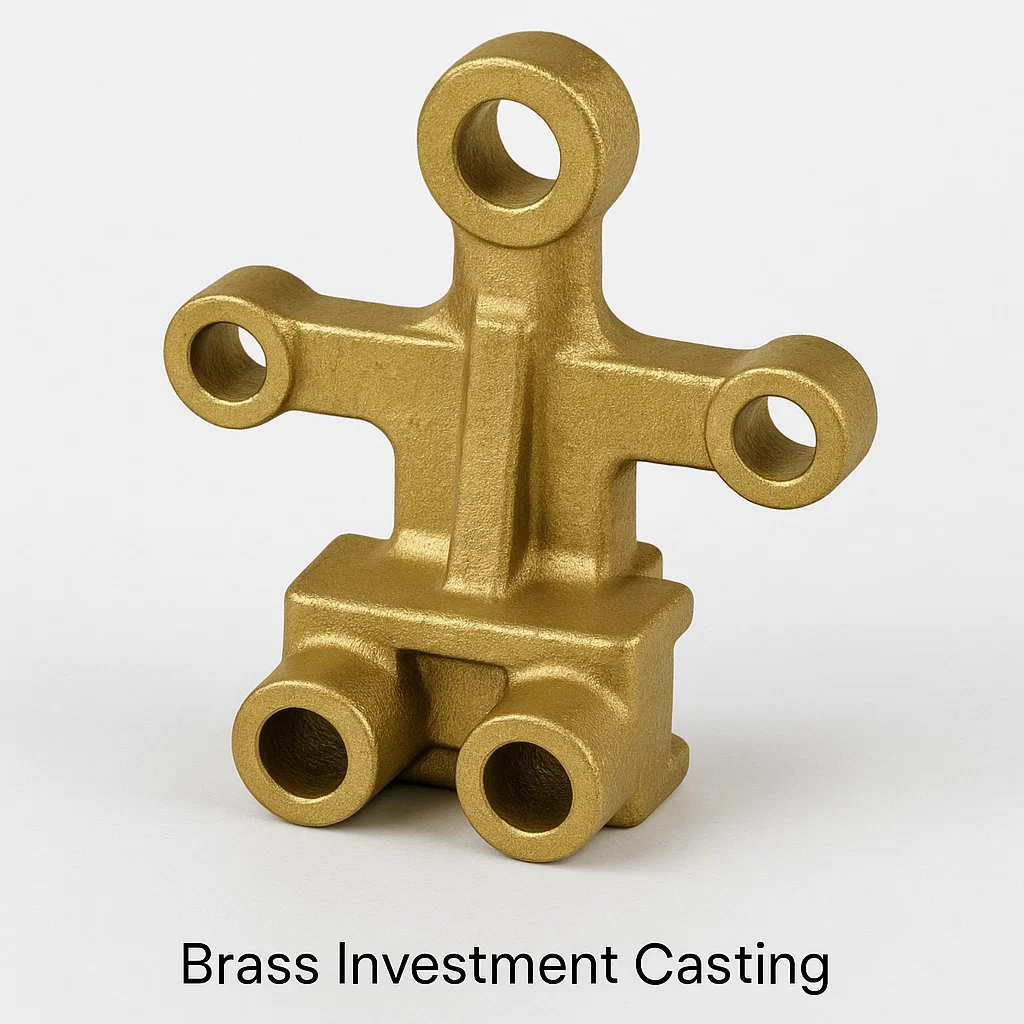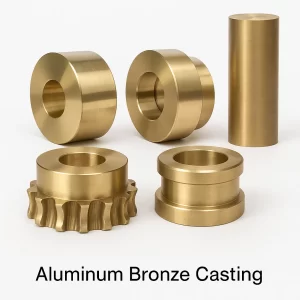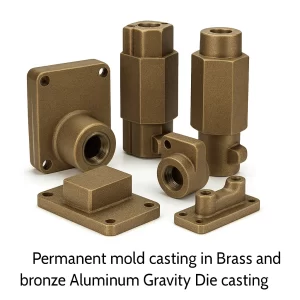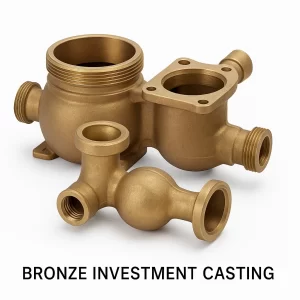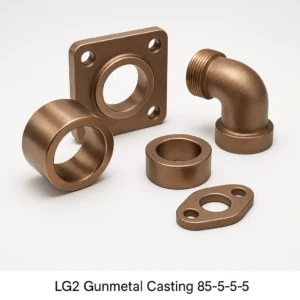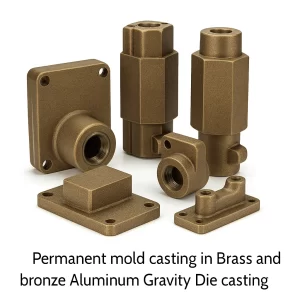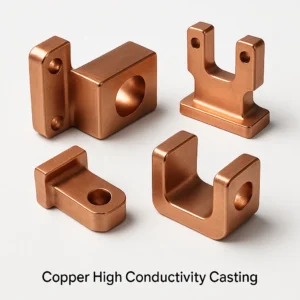Comprehensive Overview of Brass Investment Casting Services
We are one of the leading manufacturers and exporters of Brass Investment Castings, Lost Wax Brass Castings, and Precision Brass Components from India. We have been supplying high-quality brass investment cast valves, brass precision cast fittings, brass lost wax cast marine hardware, brass investment cast plumbing components, brass precision cast electrical parts, brass lost wax cast decorative hardware, brass investment cast pump components, and custom brass castings to the world market for many decades. Our state-of-the-art investment casting foundry specializes in producing premium brass castings using advanced lost wax process, ceramic shell molding, vacuum casting, centrifugal casting, CNC machining, surface finishing, and comprehensive quality control systems. With over three decades of global experience in brass investment casting, we serve diverse industries including plumbing and sanitation (faucet bodies, valve components, fitting assemblies), marine and yacht hardware (deck fittings, cleats, hinges, latches), architectural and decorative (door hardware, railings, ornamental castings), electrical and electronics (connectors, terminals, housings, grounding components), industrial valves (ball valve bodies, gate valve components, check valve parts), hydraulic and pneumatic (manifold blocks, valve bodies, adapter fittings), musical instruments (brass instrument components, bells, valves), jewelry and fashion (buckles, clasps, decorative elements), and general engineering (precision components, custom brass parts). Our expertise encompasses working with various brass alloys including Free Cutting Brass C36000 (excellent machinability), Yellow Brass C85800 (good castability and strength), Red Brass C83600 (superior corrosion resistance), Naval Brass C46400 (marine applications), Silicon Brass (enhanced corrosion resistance), Lead-Free Brass (NSF/ANSI 61 compliant for potable water), and custom brass alloys meeting specific requirements. We manufacture brass investment castings ranging from 5 grams to 25 kg with dimensions from 10mm to 800mm, maintaining dimensional accuracy ±0.1-0.5mm, excellent surface finish Ra 1.6-3.2 μm as-cast, wall thickness 0.8-50mm, superior detail reproduction, compliance with ASTM B505, ASTM B584, BS 1400, ISO standards, and reliable long-term performance in plumbing, marine, architectural, and industrial applications.
Brass Investment Casting Process (Lost Wax Process)
Brass Investment Casting (also called lost wax casting or precision casting) is a manufacturing process producing near-net-shape brass components with excellent dimensional accuracy, superior surface finish, and intricate detail reproduction. The process dates back thousands of years but modern techniques achieve precision tolerances and consistent quality suitable for demanding industrial applications.
Process Steps
Pattern Creation: Master patterns produced using CNC machining, 3D printing, or traditional sculpting, patterns made from wax, plastic, or metal depending on production volume, rubber molds made from master patterns for wax injection, pattern accuracy critical as final casting replicates pattern dimensions.
Wax Injection: Molten wax injected into rubber molds at 60-70°C under pressure 200-700 kPa, wax patterns cooled and removed from molds, pattern inspection for completeness and dimensional accuracy, wax pattern weight typically 5-15% of final brass casting weight, cycle time 30 seconds to 5 minutes depending on size.
Assembly: Multiple wax patterns assembled onto wax sprue tree (gating system), patterns positioned optimizing casting quality and material yield, typically 5-50 patterns per tree depending on size, gates and risers designed ensuring proper brass flow and solidification, tree assembly critical for casting success.
Shell Building: Wax tree dipped in ceramic slurry (colloidal silica binder plus refractory particles), first coat fine slurry (200-325 mesh) for surface finish, stuccoed with coarse refractory sand (16-30 mesh), dried in controlled humidity chamber, process repeated 5-10 layers achieving shell thickness 6-15mm, final shell strength sufficient for molten brass containment, drying time 4-8 hours per layer, total shell building time 3-7 days.
Dewaxing: Ceramic shells heated in steam autoclave 130-150°C melting wax flowing out, or flash dewaxing in furnace 150-200°C burning out wax, shells inverted allowing wax drainage, wax reclaimed and recycled, shells inspected for cracks or defects after dewaxing.
Shell Firing: Dewaxed shells fired in furnace 870-1050°C for 2-4 hours, high temperature strengthens ceramic shell, burns out residual wax and volatiles, creates porous refractory structure, shells preheated to 650-870°C before brass pouring reducing thermal shock.
Brass Melting and Pouring: Brass melted in induction or crucible furnaces at 950-1100°C depending on alloy, degassing and fluxing removing impurities, melt cleanliness critical for casting quality, pouring temperature 50-100°C above liquidus, molten brass poured into preheated shells by gravity or vacuum-assisted, solidification time 2-30 minutes depending on section thickness.
Knockout and Cleaning: Shells broken mechanically after brass solidification and cooling, castings separated from sprue tree by cutting or breaking, gating system recycled, shot blasting or vibratory finishing removing residual shell material and oxide scale, castings inspected for defects (porosity, inclusions, misruns, hot tears).
Finishing Operations: Gates and runners removed by cutting or grinding, welding repairs for minor defects where permitted, CNC machining for critical dimensions and tolerances, surface finishing (polishing, buffing, tumbling, plating), dimensional inspection and testing, packaging and shipping.
Investment Casting Advantages
Dimensional Accuracy: Tolerance ±0.1-0.5mm achievable (±0.004-0.020 inches), excellent repeatability part-to-part, minimal draft angles required 0-1 degree, complex geometries without secondary operations, reduces or eliminates machining requirements.
Surface Finish: As-cast surface finish Ra 1.6-3.2 μm (63-125 microinch), excellent for decorative applications, smooth internal passages, reduced finishing operations, superior to sand casting Ra 12.5-25 μm and die casting Ra 3.2-6.3 μm.
Design Flexibility: Complex geometries achievable (undercuts, internal passages, thin walls 0.8-2mm, intricate details), near-net-shape reducing material waste, integrated features eliminating assembly, design freedom for engineers and designers, rapid prototyping capability.
Material Efficiency: Minimal material waste versus machining from solid brass bar (waste reduction 50-90%), gating system recyclable, efficient for expensive brass alloys, lower total cost for complex parts.
Production Flexibility: Economical for low to medium production volumes 10-10,000 pieces annually, no expensive tooling for simple geometries, pattern changes relatively easy versus die casting, suitable for prototypes to production, multiple designs cast simultaneously.
Brass Alloys for Investment Casting
Free Cutting Brass C36000 (CDA 360)
Composition: 61.5% Cu, 35.5% Zn, 3% Pb. Properties: Excellent machinability (100% rating – reference standard), good castability, tensile strength 340-420 MPa, moderate corrosion resistance. Applications: Valve components requiring extensive machining, plumbing fittings, screw machine parts, gears, pinions, electrical components. Limitations: Contains lead (not suitable for potable water in many jurisdictions), moderate corrosion resistance.
Yellow Brass C85800 (85-5-5-5 Bronze)
Composition: 85% Cu, 5% Sn, 5% Pb, 5% Zn. Properties: Good castability and fluidity, tensile strength 230-280 MPa, hardness 60-80 HB, good general purpose alloy, economical. Applications: Plumbing fittings, valve bodies, general hardware, decorative castings, industrial components, moderate corrosion environments. Limitations: Contains lead, moderate strength.
Red Brass C83600 (SAE 660)
Composition: 85% Cu, 5% Sn, 5% Pb, 5% Zn. Properties: Superior corrosion resistance especially marine environments, tensile strength 230-260 MPa, good castability, excellent for investment casting intricate details. Applications: Marine hardware, plumbing valves, pump components, architectural hardware, decorative castings, moderate to high corrosion environments. Cost: Baseline for comparison, widely available.
Naval Brass C46400
Composition: 60% Cu, 39.25% Zn, 0.75% Sn. Properties: Excellent seawater corrosion resistance, tensile strength 380-480 MPa, high strength, good machinability. Applications: Marine hardware, propeller shafts, marine valve components, offshore equipment, coastal architectural hardware. Advantages: Superior marine performance versus standard brass.
Silicon Brass (Silicon Bronze)
Composition: 95-97% Cu, 3-5% Si. Properties: Excellent corrosion resistance and weldability, tensile strength 380-480 MPa, superior marine environment performance. Applications: Marine hardware, architectural castings, sculptures, high-end decorative elements, welded assemblies. Cost: Premium 40-60% over standard brass.
Lead-Free Brass (NSF Compliant)
Composition: Various formulations with <0.25% Pb (typically bismuth, silicon additions replacing lead), 85% Cu, balance Zn, Bi, Si. Properties: Tensile strength 300-380 MPa, good castability (inferior to leaded brass), NSF/ANSI 61 compliant for potable water. Applications: Drinking water faucets and valves, plumbing components, food processing equipment, North American potable water markets. Cost: Premium 25-40% over leaded brass, compliance requirements driving adoption.
Brass Alloy Selection Guide
| Alloy | Tensile Strength | Machinability | Corrosion Resistance | Lead Content | Typical Applications |
|---|---|---|---|---|---|
| C36000 Free Cutting | 340-420 MPa | Excellent (100%) | Moderate | 3% Pb | Machined valve components |
| C85800 Yellow Brass | 230-280 MPa | Good (70%) | Good | 5% Pb | General plumbing fittings |
| C83600 Red Brass | 230-260 MPa | Good (70%) | Excellent | 5% Pb | Marine, architectural hardware |
| C46400 Naval Brass | 380-480 MPa | Good (60%) | Excellent (marine) | Trace | Marine applications |
| Silicon Brass | 380-480 MPa | Moderate (50%) | Excellent | Lead-free | Premium marine, architectural |
| Lead-Free Brass | 300-380 MPa | Good (65%) | Good | <0.25% | Potable water contact |
Applications by Industry
Plumbing and Sanitation
Faucet Components: Investment cast faucet bodies, spouts, handles, valve cartridge housings, aerator assemblies, intricate decorative designs, thin-wall castings 1.5-3mm, superior surface finish for chrome plating, lead-free brass C89833 or C89844 for NSF/ANSI 61 compliance, production volumes 5,000-500,000 annually, tolerances ±0.2mm critical for assembly.
Valve Components: Ball valve bodies and caps sizes 1/4″ to 4″, gate valve bonnets and bodies, check valve bodies and caps, pressure reducing valve components, thermostatic mixing valve housings, complex internal passages for flow control, pressure ratings 150-600 PSI, investment casting enabling integrated features reducing assembly operations.
Plumbing Fittings: Decorative plumbing fittings and escutcheons, shower heads and body jets, tub spouts and diverters, supply line fittings, drain assemblies, chrome plating or PVD coating for corrosion and appearance, architectural grade finish quality.
Marine and Yacht Hardware
Deck Fittings: Investment cast deck cleats and fairleads, chocks and bitts, stanchion bases and brackets, pulpit and pushpit fittings, winch bases and pedestals, intricate traditional designs, superior surface finish, C83600 red brass or naval brass C46400 for seawater resistance, polished bronze appearance for luxury yachts.
Door and Hatch Hardware: Marine hinges and latches, door handles and knobs, hatch dogs and fasteners, porthole frames and dogs, complex shapes and decorative elements, excellent detail reproduction, corrosion resistance critical, sizes 25-300mm typical.
Rigging and Sailing Hardware: Turnbuckles and rigging fittings, blocks and sheaves, sail track fittings, boom and mast hardware, high-strength naval brass or silicon bronze, precision dimensions for proper rigging function.
Architectural and Decorative
Door Hardware: Investment cast door handles and knobs, escutcheon plates, door knockers, hinges and pivot assemblies, lock bodies and components, intricate decorative designs, architectural bronze finish (patina), polished brass, antique brass, custom finishes, sizes 30-250mm, premium appearance quality, production volumes 100-10,000 per design.
Railing and Balustrade: Railing brackets and connectors, newel post caps and finials, baluster components, decorative rosettes and escutcheons, complex ornamental designs reproduced precisely, historical restoration applications, custom designs for architects.
Lighting Fixtures: Chandelier arms and components, lamp bases and finials, sconce backplates and arms, decorative lighting elements, thin-wall intricate castings, excellent surface finish for plating, brass patina finishes.
Electrical and Electronics
Electrical Connectors: Precision investment cast connector bodies, terminal blocks, grounding lugs, cable glands, bus bar connectors, complex geometries ensuring proper electrical contact, tight tolerances ±0.1mm, excellent conductivity from high copper content brass.
Electrical Housings: Junction box bodies and covers, switch and outlet housings, control panel components, instrument housings, electrical enclosures, integrated mounting features, EMI/RFI shielding where required.
Grounding Components: Ground rods and clamps, lightning protection fittings, grounding lugs and terminals, bonding components, superior electrical conductivity, corrosion resistance for outdoor installations.
Industrial Valves
Ball Valves: Investment cast ball valve bodies 1/4″ to 4″ sizes, end caps and bonnets, ball components, complex internal cavity reproduction, pressure ratings 200-600 PSI (PN16-PN40), superior sealing surfaces from precision casting, reduced machining versus forged bodies, production volumes 1,000-100,000 annually.
Gate and Globe Valves: Valve bodies and bonnets, bonnet caps, gland followers, complex flow passages, cast-in seat pockets, sizes 1/2″ to 6″, high-pressure applications to 1500 PSI.
Check Valves: Swing check valve bodies, lift check valve bodies, wafer check valve bodies, dual plate check valve bodies, complex internal geometries, integrated seat designs.
Specialty Valves: Pressure relief valve bodies, control valve bodies, sampling valve components, instrumentation valve bodies, high-precision requirements, corrosion-resistant brass alloys.
Hydraulic and Pneumatic
Manifold Blocks: Hydraulic manifolds with complex internal passages, pneumatic manifold blocks, multiple ports and passages, pressure ratings 150-350 bar (2000-5000 PSI), investment casting enabling 3D internal passages impossible with drilling, weight reduction versus machined from solid, sizes 50-300mm.
Valve Bodies: Directional control valve bodies, proportional valve housings, servo valve components, flow control valve bodies, integrated features reducing assembly, precision tolerances ±0.15mm for valve cartridge fit.
Adapter Fittings: High-pressure adapters and fittings, union components, transition fittings, complex shapes reducing assembly, threaded connections NPT, BSPP, metric.
Musical Instruments
Brass Instruments: Trumpet bells, valves, and slides, trombone components, French horn bells and rotary valves, tuba components, euphonium parts, precise dimensional control for tuning and air flow, smooth internal passages, superior surface finish for lacquer or plating, traditional yellow brass for tone quality.
Woodwind Instruments: Saxophone keys and mechanisms, clarinet keys and rings, oboe and bassoon keys, flute mechanisms, intricate shapes and linkages, precise key heights and clearances, corrosion-resistant brass alloys.
Jewelry and Fashion
Belt Buckles: Investment cast custom buckles, designer buckles, western buckles, military buckles, intricate relief designs, 3D sculptural elements, polished brass, antiqued brass, plated finishes (nickel, chrome, gold), sizes 30-120mm, production 100-100,000 pieces.
Fashion Hardware: Handbag clasps and closures, zipper pulls, buttons, decorative hardware, jewelry findings and components, complex artistic designs, excellent detail reproduction, various finishes.
Manufacturing Capabilities and Quality Control
Advanced Investment Casting Foundry
Pattern Making: In-house pattern shop with CNC machining, 3D printing (SLA, SLS) for rapid prototypes, rubber mold making from master patterns, injection wax capability 5g to 2kg patterns, pattern library with 10,000+ designs.
Shell Building: Automated dip coating systems, climate-controlled drying chambers (temperature ±2°C, humidity ±5% RH), ceramic slurry mixing and monitoring, shell building capacity 50,000-200,000 pieces monthly depending on size.
Melting and Casting: Induction melting furnaces 50-500 kg capacity, precise temperature control ±5°C, degassing and fluxing systems, vacuum-assisted casting capability for thin-wall complex geometries, centrifugal casting for cylindrical components, pouring capacity 10,000-50,000 castings monthly.
Heat Treatment: Solution annealing and stress relief furnaces, temperature control ±10°C, atmosphere control preventing oxidation, process certification and documentation.
CNC Machining and Finishing
Machining Centers: 15+ CNC vertical machining centers, CNC lathes and turning centers, 5-axis machining for complex surfaces, drilling, tapping, boring, threading operations, tolerances ±0.02-0.05mm achievable.
Surface Finishing: Vibratory tumbling and deburring, media blasting (glass bead, ceramic, aluminum oxide), buffing and polishing (mirror, satin, antiqued finishes), brushing and texturing, achieving Ra 0.2-3.2 μm depending on requirements.
Surface Treatment: Electroplating (chrome, nickel, gold, silver), powder coating, e-coating, anodizing (brass doesn’t anodize but compatible coatings available), patina treatments (verde, brown, black oxide), clear protective coatings (lacquer, wax).
Comprehensive Quality Control
Material Verification: Optical emission spectrometry (OES) verifying brass composition within ASTM specifications ±1%, hardness testing Rockwell or Brinell, tensile testing per ASTM B505 on sample castings, chemical analysis confirming lead content for compliance.
Dimensional Inspection: CMM inspection ±0.003-0.005mm accuracy for complex 3D geometries, precision measuring instruments (micrometers, calipers, gauges), surface finish measurement with profilometers Ra verification, thread inspection with gauges, first article inspection (FAI) complete verification before production.
Non-Destructive Testing: X-ray radiography detecting internal porosity and inclusions per ASTM E155, liquid penetrant testing for surface cracks per ASTM E1417, pressure testing for pressure-containing components, ultrasonic testing for wall thickness and internal soundness.
Visual Inspection: 100% visual inspection for surface defects, comparison to approved samples, finish quality verification, dimensional spot checks, defect classification per customer specifications.
Statistical Process Control: SPC monitoring of critical dimensions, control charts tracking process stability, Cpk capability analysis targeting ≥1.33, continuous improvement initiatives.
Technical Standards and Specifications
ASTM Standards
ASTM B505: Standard specification for copper alloy continuous castings including brass investment castings, defines mechanical property testing procedures, tensile testing, hardness requirements, applicable to red brass, yellow brass alloys.
ASTM B584: Standard specification for copper alloy sand castings for general applications, covers similar brass alloys, reference standard for investment castings requiring mechanical properties.
ASTM B36: Standard specification for brass plate, sheet, strip, applicable to wrought brass for comparison, property requirements.
International Standards
BS 1400: British standard for copper alloy castings, covers brass alloy compositions and properties, LM series designations, mechanical requirements.
DIN EN 1982: European standard for copper and copper alloy castings, composition specifications, testing requirements, CC series designations for cast copper alloys.
ISO 1190: Investment castings dimensional tolerances, general tolerance grades (CT4 to CT9), linear dimension tolerances, surface finish requirements.
Industry-Specific Standards
NSF/ANSI 61: Drinking water system components, lead content requirements <0.25% for wetted surfaces, leaching tests for potable water compliance, mandatory for plumbing fixtures in North America.
ASME B16.18: Cast copper alloy solder joint pressure fittings, dimensional requirements for plumbing fittings, applicable to investment cast brass fittings.
SAE J461: Copper and copper alloy castings automotive and industrial, composition and property requirements.
Advantages Over Alternative Processes
Versus Sand Casting: Investment casting dimensional accuracy ±0.1-0.5mm vs. ±1.5-3.0mm sand casting, surface finish Ra 1.6-3.2 μm vs. 12.5-25 μm, minimal draft angles 0-1° vs. 3-5°, superior detail reproduction, thinner walls possible 0.8mm vs. 3mm minimum, better mechanical properties from finer grain structure, economical for complex parts low to medium volumes.
Versus Die Casting: Investment casting allows heat treatment and welding (die casting generally not heat treatable), thicker walls and heavier sections possible, lower tooling cost for low volumes, superior for intricate decorative designs, better for brass alloys (die casting primarily aluminum and zinc), economical for 10-10,000 pieces vs. >10,000 for die casting.
Versus Machining from Bar: Investment casting 50-90% material savings, complex shapes impossible or uneconomical to machine, integrated features eliminating assembly, faster production for complex parts, lower cost for volumes >100 pieces, design flexibility (undercuts, internal passages).
Versus Forging: Investment casting produces near-net-shape reducing machining, complex geometries not possible with forging, lower tooling costs, better for decorative and artistic designs, forging advantages in highest strength applications and very high volumes.
Design Guidelines for Brass Investment Casting
Wall Thickness: Minimum wall 0.8-1.5mm for small castings, 1.5-3mm for medium castings, 3-6mm for large castings ensuring proper metal flow and soundness, uniform wall thickness preferred avoiding hot spots and shrinkage, maximum thickness 50mm achievable with proper gating.
Draft Angles: Minimal draft required 0-1 degree due to wax pattern extraction, complex undercuts possible with multi-part molds, design freedom versus other casting processes, sharp corners and edges achievable.
Tolerances: Standard tolerance ±0.2-0.5mm for dimensions <100mm per ISO 1190 grade CT5-6, ±0.5-1.0mm for 100-300mm, critical dimensions machined to ±0.02-0.1mm, positional tolerance ±0.1-0.3mm, flatness/perpendicularity 0.1-0.3mm achievable.
Surface Finish: As-cast Ra 1.6-3.2 μm typical (excellent for decorative applications), internal passages Ra 3.2-6.3 μm, machined surfaces Ra 0.4-1.6 μm, polished surfaces Ra 0.1-0.4 μm achievable.
Detail Reproduction: Excellent for intricate patterns, raised or recessed lettering minimum 0.5mm height/depth, sharp edges and corners, engraved details, logos and trademarks, textures and patterns, artistic sculptural elements.
Gates and Risers: Gating system designed by foundry engineers, gate location affects surface finish, secondary machining removes gates, gate design critical for casting success, customer approval of gate locations on critical surfaces.
Shrinkage Allowance: Brass solidification shrinkage ~1.5-2.0%, patterns oversized accordingly, critical dimensions verified and compensated, experienced foundry adjusts for dimensional accuracy.
Why Choose Our Brass Investment Casting Services
Three Decades of Investment Casting Excellence
Established 1990: 30+ years producing brass investment castings for plumbing, marine, architectural, industrial customers across 40+ countries. Proven Performance: Delivered 20+ million brass investment castings, 98% on-time delivery, <0.8% defect rate, supplying major plumbing manufacturers, marine hardware companies, architectural specifiers. Certifications: ISO 9001:2015 certified quality management, ISO 14001 environmental management, NSF/ANSI 61 compliance for lead-free brass plumbing components.
Comprehensive Brass Alloy Expertise
Multiple Brass Alloys: C36000 free cutting for machinability, C85800 yellow brass economical general purpose, C83600 red brass marine and architectural, C46400 naval brass marine applications, silicon brass premium marine, lead-free brass NSF/ANSI 61 compliant potable water. Material Sourcing: High-purity copper and zinc from certified suppliers, complete material certificates with heat numbers, composition control within ASTM specifications ±1%, lead-free formulations meeting NSF standards.
Advanced Investment Casting Technology
Lost Wax Process: State-of-the-art ceramic shell building with automated systems, vacuum-assisted and centrifugal casting for complex geometries, dimensional accuracy ±0.1-0.5mm, surface finish Ra 1.6-3.2 μm as-cast, wall thickness capability 0.8-50mm, complex undercuts and internal passages. Pattern Making: In-house pattern shop, 3D printing rapid prototyping 5-10 days, rubber mold making, injection wax patterns, pattern library 10,000+ designs, custom pattern development 2-4 weeks.
Integrated Manufacturing Services
Complete Solution: Casting to finished product, CNC machining for critical dimensions, surface finishing (polishing, plating, patina), assembly capabilities, packaging and logistics, one-stop solution reducing lead times and coordination. Surface Treatment: In-house capabilities including vibratory finishing, buffing, polishing, relationships with chrome platers, powder coaters, approved suppliers for specialized finishes.
Engineering and Design Support
Design for Manufacturability: DFM review optimizing designs for investment casting, casting simulation (MAGMA, ProCAST) predicting defects, recommendations for cost reduction, tolerance analysis, prototype development and testing 4-6 weeks. Custom Development: Reverse engineering from samples or sketches, 3D CAD modeling, new product development support, artistic and decorative designs, proprietary designs with confidentiality.
Competitive Global Pricing
Cost Advantage: 30-40% lower cost versus European and North American foundries, competitive with Chinese investment foundries offering superior quality control and communication, transparent pricing with detailed cost breakdowns. Volume Pricing: 10-100 pieces: baseline pricing, 100-1,000: 10-15% discount, 1,000-10,000: 15-25%, >10,000: 25-35%, blanket orders with scheduled releases: additional 5-10%. Value Engineering: Design optimization reducing brass weight, pattern optimization for higher yields, manufacturing efficiency improvements.
Flexible Production Volumes
Low Volume Capability: Economical for prototype quantities 10-50 pieces, pre-production runs 50-500 pieces, specialized components, custom designs. Medium Volume Production: Efficient production 500-10,000 pieces annually, dedicated pattern inventory, scheduled production runs, consistent quality. High Volume Capability: Large orders >10,000 pieces with optimized tooling, automated processing, volume pricing, inventory management programs.
Global Logistics and Service
Worldwide Export: North America (35%), Europe (30%), Middle East (15%), Asia-Pacific (12%), Australia (8%), established customers in plumbing, marine, architectural, industrial sectors. Shipping: Air freight expedited 5-7 days, sea freight economical 25-40 days, consolidated shipments, export packaging preventing damage and corrosion. Documentation: Material certificates ASTM/BS/DIN, test reports, dimensional inspection reports, REACH/RoHS compliance declarations, NSF certificates for lead-free brass, country of origin certificates. Lead Times: Prototype patterns and samples 4-6 weeks, production tooling 6-8 weeks, production castings 4-8 weeks depending on volume and complexity, machined/finished components add 2-3 weeks. On-Time: 98% on-time delivery over 5 years.
Frequently Asked Questions
Q1: What is investment casting and what are the advantages for brass components? Investment casting (lost wax process) creates precision brass castings by surrounding wax patterns with ceramic shell, melting out wax, pouring molten brass into cavity. Key advantages: Dimensional accuracy ±0.1-0.5mm (10× better than sand casting), excellent surface finish Ra 1.6-3.2 μm (suitable for decorative applications, reduced finishing), complex shapes with undercuts and internal passages, thin walls 0.8mm minimum, near-net-shape reducing machining 50-90%, excellent detail reproduction for artistic designs, economical for low to medium volumes 10-10,000 pieces. Ideal for decorative brass hardware, precision valve components, marine fittings, plumbing fixtures, complex parts where machining would be expensive.
Q2: Which brass alloy should I select for my application? C36000 Free Cutting: Best machinability for extensively machined parts, valve components, electrical connectors, contains lead (3%). C85800 Yellow Brass: Economical general purpose, good castability, plumbing fittings, hardware, contains lead (5%). C83600 Red Brass: Superior corrosion resistance, marine hardware, architectural elements, plumbing valves, contains lead (5%). Naval Brass C46400: Excellent marine/seawater resistance, offshore hardware, marine valves, high strength, low lead. Lead-Free Brass: NSF/ANSI 61 compliant for potable water, faucets and drinking water valves, North American plumbing market requirement, 25-40% cost premium. Silicon Brass: Maximum corrosion resistance, premium marine and architectural, sculptural elements, weldable, 40-60% premium. Consult our engineers with application details (environment, strength, machining, regulatory compliance).
Q3: Can brass investment castings be plated or finished? Yes, brass investment castings excellent for plating and finishing due to superior as-cast surface finish Ra 1.6-3.2 μm. Common finishes: Chrome plating (decorative or hard chrome), nickel plating (bright, satin, black nickel), gold plating, silver plating, powder coating, antiqued brass patina (brown, verde green), black oxide, polished brass (mirror, satin), brushed finishes, clear lacquer protective coating. Process: Castings deburred and polished, pre-treatment (cleaning, activation), plating, post-treatment as required. Applications: Chrome-plated faucets and fixtures, antiqued architectural hardware, polished marine hardware, powder-coated electrical components. We provide in-house finishing or work with approved platers/finishers.
Q4: What are typical lead times and minimum order quantities for brass investment castings? Prototype/Samples: 4-6 weeks for new designs including pattern making (3D printed or machined), wax patterns, shell building, casting, basic finishing, MOQ 10-50 pieces depending on size and complexity. Production Tooling: 6-8 weeks for rubber mold making from approved master pattern, injection wax tooling, sampling, dimensional verification, MOQ 100-500 pieces economical. Production Castings: 4-8 weeks for repeat orders depending on volume and complexity, MOQ 100-1,000 pieces (lower MOQ possible at higher piece price), high volume >10,000 pieces 8-12 weeks. Machined/Finished: Add 2-3 weeks for CNC machining, plating, surface finishing operations. Expedited Service: 3-4 weeks possible for urgent requirements with surcharge.
Q5: What quality assurance and testing do you provide? Material Certification: Chemical composition analysis OES verifying brass alloy per ASTM specifications ±1%, lead content verification for NSF compliance, mechanical properties (tensile, hardness) per ASTM B505, heat number traceability from raw material to finished casting. Dimensional Inspection: CMM inspection reports with actual measurements vs. drawings, first article inspection (FAI) complete verification, in-process inspection critical dimensions, final inspection 100% visual and dimensional spot checks. NDT Testing: X-ray radiography for internal porosity and inclusions (critical components), liquid penetrant testing for surface cracks, pressure testing for pressure-containing components (hydraulic, plumbing). Compliance Documentation: NSF/ANSI 61 certificates for lead-free brass, REACH/RoHS compliance declarations, material safety data sheets (MSDS), country of origin certificates. Process Control: SPC monitoring critical dimensions, Cpk analysis, continuous improvement programs, corrective action procedures.
Contact Us Today – Request Quote for Brass Investment Castings
Ready to discuss your brass investment casting requirements for plumbing fixtures, marine hardware, architectural elements, valve components, decorative hardware, or custom brass castings?
Request a Quote: Send drawings (PDF, DWG, STEP, IGES), photos, samples, or sketches, specifications including brass alloy, quantity, surface finish, tolerances, application details to sales@jambrass.com for detailed quotation within 48 hours.
Engineering Support: Email design concepts for design for manufacturability (DFM) review, material selection guidance, cost optimization recommendations, prototype development.
Call Us: +91-22-43449300 / +91-22-43449323 (Monday-Saturday, 9:00 AM – 6:00 PM IST)
Office Address: 1406, 14th Floor, Dalamal Tower, Nariman Point, Mumbai – 400021, Maharashtra, India
Factory Address: Plot 10B, GIDC Industrial Estate, Shanker Tekari, Udyognagar, Jamnagar, Gujarat, India – 361004
Contact Person: Mr. Mehul Vora
Email: sales@jambrass.com

